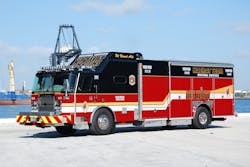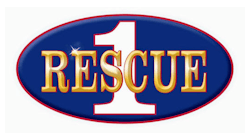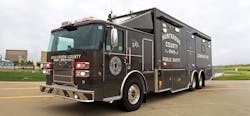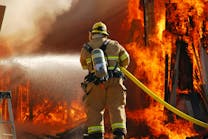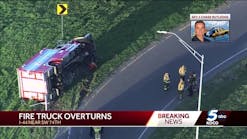An indication the economy is recovering is that apparatus sales are on the upswing, the trend for rescue rigs has been bigger, fancier and better equipped, according to manufacturers.
While there are still plenty of budget-conscious rescue apparatus being built, there’s a growing number of high-end vehicles that incorporate command centers and fire suppression, in addition to traditional rescue functions.
“It’s feeling a lot like 2006, 2007 when there were a lot of rescue trucks with command functions built-in,” said Bill Himstedt, E-ONE’s director of sales and product manager. “Budgets are going to become larger as fire pumps come back and the vehicles get bigger and become multipurpose.”
Doug Kelley, rescue product manager for KME, has similar anecdotal experience, saying his company has noticed an uptick in rescue vehicles that incorporate walk-in and walk-around features.
“One of the trends we’ve seen is more combination units,” Kelley said. “We have departments that want the front third of the truck built with a small command center, rehab area and the remaining two-thirds as a traditional walk-around rescue for equipment. It’s become fairly popular.”
“We’ve sold a lot of custom trucks in the last year,” said Mike Marquis, vice president of rescue operations for Rescue 1, a builder in Manasquan, NJ. “There are more departments buying whatever they want now than there was a year ago.”
Marquis said the company has seen a larger percentage of rescues that carry water for fire suppression, even though the option might add $70,000 to $100,000 to the cost of a rescue rig.
“We build units with 200- to 250-gallon water tanks and a 250 gpm pto pump,” Marquis said, noting that the addition of foam means that there’s plenty of punch to knock out a car fire or handle fuel leaks at crash scenes.
Bob Sorensen, vice president of sales for SVI, a rescue truck builder in Fort Collins, CO, said his company has experienced growth in combination apparatus, those with walk-in capabilities and are able to multi-task.
“We’ve seen a move to special operations vehicles,” Sorensen said. “Instead of just being a Hazmat response vehicle, or a command center, they handle many different tasks.”
Shane Braun, sales and marketing manager for Pierce’s rescue products said he's noticed fire departments taking more time to design just what they want rather than simply buying whatever the company offers. Some departments can take up to two years to specify and bid rescue apparatus.
Himstedt, from E-ONE, said he’s pleased the rescue apparatus market is recovering. When the economy sank, so did the sale of rescue trucks.
“Rescue trucks are almost a luxury item for some departments,” Himstedt said. “If a department has to lose a piece of apparatus because of budget concerns, rescues are usually the first to go to save money.”
Departments that need rescues in their fleet had previously been specifying smaller units on commercial cabs and chassis, but lately, those departments are looking at tandem axle trucks with 40-foot overall lengths and custom cabs and chassis.
Over the last six months, Himstedt said rescue trucks are becoming larger, up to 43 feet in overall length, and able to multi-task.
Himstedt also said units are being constructed by E-ONE using wet fire suppression systems as well as foam units with no pumps. A growing number are being equipped with on-board hydraulic extrication tool power supplies that can power up to four to six tools at the same time. That trend surprises Himstedt, noting that a number of tool manufacturers are selling battery-powered extrication equipment.
“Rescue truck capabilities are becoming more and more impressive,” Himstedt said. “We are seeing a lot of well-equipped, well-designed rescues out there. Some of them are pretty elaborate.”
KME’s Kelley said he’s noticed a trend indicating fire departments are willing to spend a little more to get what they want.
One of the items firefighters seem to be willing to spend more dollars on is LED lighting, Kelley said. The price of LED lighting continues to drop and it continues to get brighter and smaller in configuration, he added, noting all those factors contribute to the growing popularity.
Kelley mentioned particularly a 42-inch long, 4-inch tall strip of LEDs that can go on the brow of an apparatus creating tremendous lighting for a variety of applications.
The improvements to LED lighting means fire departments don’t necessarily need to specify huge generators that take up space and can be expensive. It now means departments can opt to have a PTO water pump instead of a hydraulic generator competing for that same PTO shaft, Kelley said.
Kelley added that fire departments are paying more attention to the way equipment is stored and mounted in rescue trucks these days than ever before. Tip-down and slide-out trays and shelving are becoming more popular and extruded aluminum track tool mounting systems are more popular than ever, he said.
“Departments are buying rescues to fit the job,” Kelley said. “Whether departments are buying big or small rescues, they’re buying ones that are just big enough for their needs.”
Marquis, from Rescue 1, said he’s finding customers aren’t afraid to customize their trucks as their needs dictate. If they need a foam system, they’ll specify it, along with fire suppression equipment that amounts to a skid unit with a portable pump and a water tank up to 250 gallons in size.
If departments don’t want to use up cabinet space by installing a skid-type unit, Marquis said Rescue 1 will deconstruct the units and fit the components in available spaces to preserve valuable compartment space. There is a premium to that option, but Marquis said many departments are willing to pay the price in exchange for more compartment space to carry loose equipment.
Rescue apparatus are now more than ever being equipped with awning for shade and shelter from weather elements, according to Marquis. Rescue units are increasingly being used for rehab stations and the awning provides the protection responders need. In fact, he said, Rescue 1 is building apparatus with flip-out compartment steps, which double as seating for firefighters, complete with a cushion accessory.
Another option Rescue 1 will be introducing in April is a curbside access stairwell for firefighters to more easily and safely retrieve items stored in compartments on top of the apparatus, Marquis said.
Traditionally, rescue apparatus often has stair access at the rear of the apparatus and Marquis said Rescue 1 has been making those apparatus for a while, but the side stairwell will keep responders from stepping off the apparatus at the rear and being vulnerable to traffic that might hit the rear of the rig.
“We think it’s an idea that’s going to catch on,” Marquis said.
SVI’s Sorensen has seen a small, but surprising trend toward commercial cabs and chassis. “It’s been a trend for the last couple of years,” he said, noting that Freightliner has been recording record sales recently. The wait time for a Freightliner chassis is seven months while custom chassis is usually ready in five months or less.
And like Kelley, Sorensen has seen a move to LED lighting. “The overwhelming majority of the apparatus we build have LED warning and scene lighting,” Sorensen said. “Once one those lights are turned on, and firefighters see how white and bright the light is, they’re immediately sold.” Many trucks SVI build these days are also equipped with LED headlight packages, even though the option can add as much as $2,000 to the overall price tag.
Rescue trucks rolling out of SVI are increasingly equipped with breathing air compressor and cascade systems for SCBA refilling, Sorensen said, adding that many rescue trucks are designed to haul 15 to 20 extra bottles of fresh breathing air.
And, like all the other builders, Sorensen said he has more big rigs being delivered, including one to Houston that came in at 40 feet long and a unit to Calgary that came at over 42 feet long. Ironically, that one is assigned to the downtown, hi-rise district. Sorensen explained the department has a certain protocol for fires in tall buildings that requires a lot of equipment to be stored on the apparatus and then hauled into the building on pre-loaded hand trucks, a protocol that requires lots of cabinet space.
“They are tending to keep getting longer,” Sorensen said. “Departments are looking for rescues that can multitask.”
“Departments are really doing their homework and putting equipment just where they want it and figuring out exactly how they want to get at it,” Braun said. In years past, departments would place an order for a rescue apparatus and not have a clue where to put all their equipment when they took delivery.
“They’re learning from their mistakes,” he said. “Now, they are much more engaged. They want to be in the forefront now much more than ever before.”
He said departments are far more conscious of access to roof compartments and are designing access modes to the top of apparatus with far more thought toward safety than ever before. Pull down ladders, although still used, are often traded for stairs and other methods of egress.
There’s a lot of space at the top of the apparatus and departments want to use it safely, he said, noting that anything above the 64-inch compartment door opening is difficult to retrieve, even with built in steps, so some things are best stored overhead.
Combination walk-in, walk-around rescue apparatus seems to be more of a trend on the East Coast than anywhere else, Braun noted, adding that their existence is heavily influenced by FDNY which has used combination units for years. Although those kinds of apparatus might be limited to the East Coast, Braun said Pierce has a backlog that type that will last well into this year.
Braun said one trend he’s noticed is departments spending more time thinking about the mission of the apparatus and building it for their particular needs.
“Specifications are based around mission,” Braun said. “Departments are designing particular needs right into the trucks.”
To do that, Braun said, departments are looking at the “big pieces” the new rescue must incorporate, like 35-foot ladders, or a particular generator. From that, he said, departments “fill in the voids” around the big pieces with all the smaller, but no less important components and equipment.
“There’s a saying that rescues are like big boxes of air,” Braun said. “The idea is to use up every cubic inch of space as best as possible.”
